The Pietà from Bílsko remains virtually unknown in the professional literature. Older artwork inventories from the Strakonice region describe it as a Baroque work installed in a niche of the Baroque altarpiece in the Church of St James, Son of Zebedee, in Bílsko. The entries in the parish memorial book corroborate the practise of reverence to the local Lady of Sorrows and the frequent repairs made to the sculpture, which was damaged by woodworm. By the end of the 20th century, the carving was dilapidated and only the top layer of polychromy held together some parts of the pulverised, woodworm-eaten wood.
If not for its comprehensive restoration, portions of the carving would fall apart. The demanding restoration work carried out by the National Gallery Prague’s Restoration Studio took several years. It clearly showed that the Pietà from Bílsko is a carving of rare quality, making it an important addition to the late-Gothic artworks from southern Bohemia known to date. In spite of its considerable damage, the carving can be compared with the best works by the Master of the Lamentation of Christ of Žebrák and the Master of the Lamentation of Christ of Zvíkov.
The circumstances of its commissioning are also interesting, as it is highly likely the Pietà was commissioned by Zdeněk Lev of Rožmitál, Chief Burgrave of the Kingdom of Bohemia (d. 1535) for his domain. The installation of the newly restored carving in the permanent exhibition in the Convent of St Agnes of Bohemia describes the demanding restoration work and offers a comparison to carvings attributed to the Master of the Lamentation of Christ of Žebrák and the Master of the Lamentation of Christ of Zvíkov. Uniquely, visitors may also consider whether the Pietà might have been part of another surviving carving of Bílsko. To this end, the Aleš South Bohemian Gallery in Hluboká has loaned the carving of St James, Son of Zebedee, and Mary Magdalene.
















